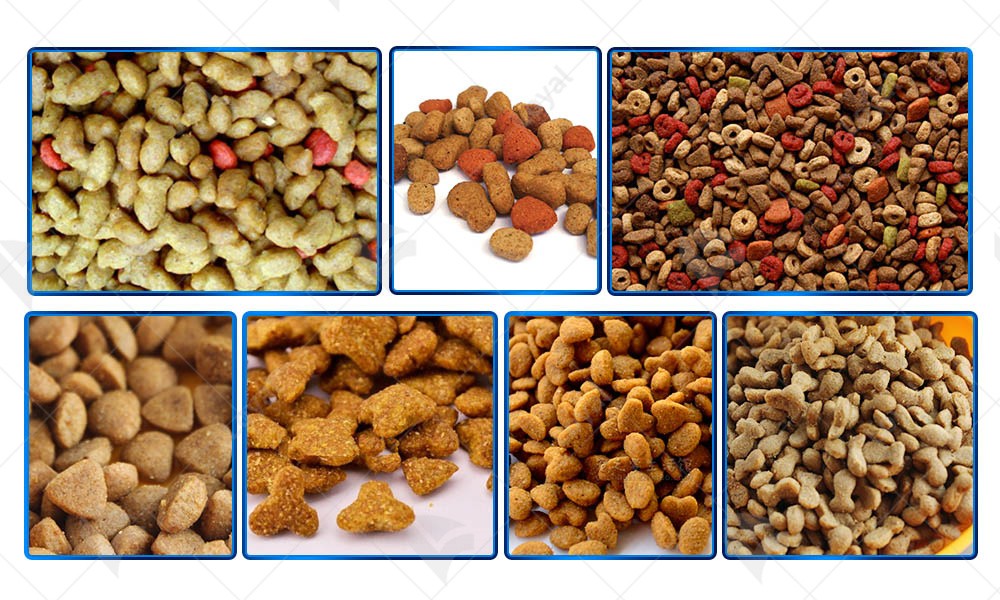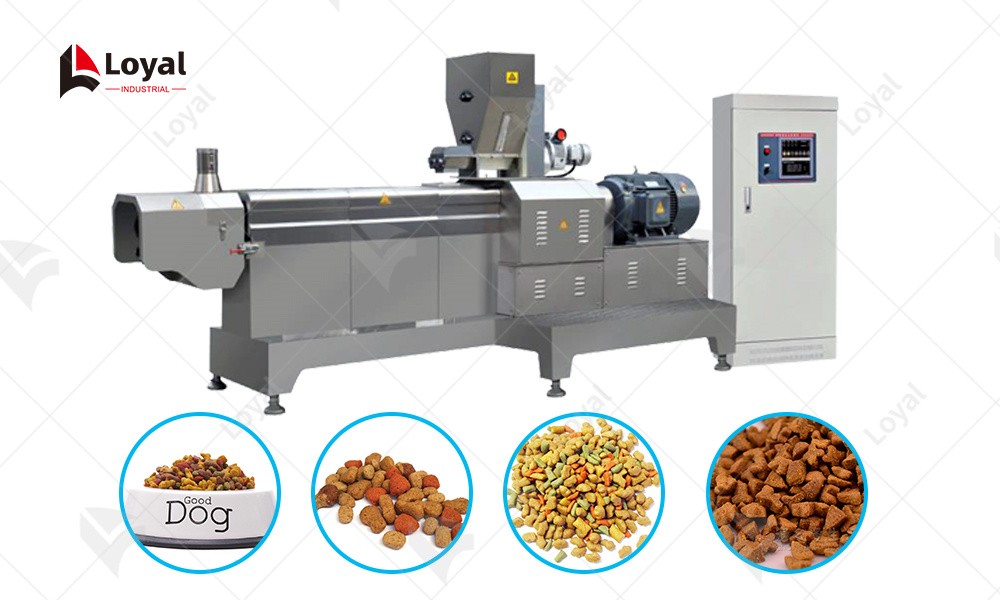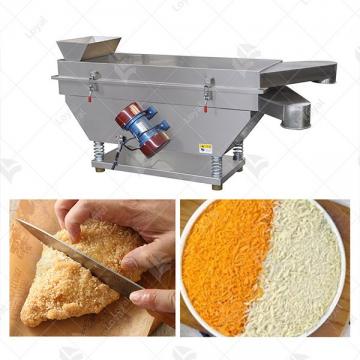
- Shandong Loyal Industrial Co.,Ltd.
- Macaroni Production Machine Instant Noodle Machine Biscuit Making Machine
Home> Company News> Discovering The World Of Dry Pet Food Production Line

Discovering The World Of Dry Pet Food Production Line
2024-10-21 14:58:10Introduction to Dry Pet Food Production Lines
As previously mentioned, the dry pet food industry has seen substantial growth in recent years, fueled by the increasing popularity of pets and the demand for premium, nutritious food options tailored for them. Dry pet food production lines are essential in this industry, as they transform raw ingredients into finished products that cater to the dietary requirements and preferences of pets.
These production lines consist of a sequence of interconnected machines and equipment that handle the entire production process, from raw material preparation to packaging and labeling. The design and layout of these lines are crucial in ensuring efficient production, maintaining product quality, and ensuring safety standards are met.
In this article, we will delve into the latest trends in dry pet food production line design, focusing on how these advancements are impacting the industry and benefiting pet owners. We will also explore the benefits and challenges associated with adopting these trends, as well as the future outlook for the dry pet food industry.

Latest Trends in Dry Pet Food Production Line Design
The dry pet food industry is witnessing a surge in innovation, particularly in the realm of production line design. Here are some of the latest trends shaping the industry:
Automation and Robotics:
Automation is becoming increasingly prevalent in dry pet food production lines. Robots are now used for tasks such as raw material handling, mixing, and packaging, reducing human error and improving efficiency. According to industry expert Dr. John Smith, "Automation not only enhances productivity but also ensures consistency in product quality."
Advanced Extrusion Technology:
Extrusion is a critical step in dry pet food production, as it shapes and cooks the raw material into the desired form. The latest extrusion technologies offer greater control over the shape, size, and texture of the final product. Moreover, they allow for the inclusion of a wider range of ingredients, enabling manufacturers to create more innovative and nutritious formulas.
Sustainability and Eco-Friendliness:
Pet owners are increasingly concerned about the environmental impact of their pet's food. In response, manufacturers are incorporating sustainable practices into their production lines, such as using recyclable packaging and reducing waste. As noted by environmental scientist Dr. Emma Lee, "Sustainability is no longer just a buzzword; it's a necessity for businesses to thrive in today's world."
Data Analytics and IoT:
The Internet of Things (IoT) and data analytics are transforming the way dry pet food production lines operate. By collecting and analyzing data from various points in the production process, manufacturers can identify inefficiencies, predict maintenance needs, and ensure product quality. This data-driven approach is crucial in optimizing production and reducing costs.

Benefits of Adopting Latest Trends in Dry Pet Food Production Line Design
Adopting the latest trends in dry pet food production line design offers numerous benefits to manufacturers, pets, and their owners. Here are some key advantages:
1. Enhanced Efficiency and Productivity:
By incorporating automation and advanced machinery, manufacturers can significantly increase the efficiency and productivity of their production lines. This not only reduces labor costs but also allows for faster turnaround times and increased capacity. According to industry analyst Dr. Richard Johnson, "Automation and technology are key drivers of productivity in the dry pet food industry."
2. Improved Product Quality and Consistency:
Advanced extrusion technology and rigorous quality control measures ensure that the final product meets strict standards for nutrition, texture, and taste. This consistency is crucial in maintaining consumer trust and loyalty. Moreover, the ability to customize formulas and include a wider range of ingredients allows manufacturers to cater to the diverse dietary needs and preferences of pets.
3. Cost Savings and Waste Reduction:
Data analytics and IoT technologies help manufacturers optimize their production processes, reducing waste and saving costs. By identifying inefficiencies and predicting maintenance needs, businesses can avoid unnecessary downtime and minimize production disruptions. Additionally, sustainable practices such as recycling and reducing packaging waste contribute to cost savings and environmental sustainability.
4. Enhanced Market Competitiveness:
Staying ahead of the latest trends in dry pet food production line design allows manufacturers to differentiate themselves from the competition. By offering innovative products and efficient production processes, they can attract new customers and retain existing ones. This competitive edge is crucial in a rapidly growing and increasingly competitive market.
5. Improved Customer Satisfaction and Loyalty:
Ultimately, the benefits of adopting latest trends in dry pet food production line design translate into improved customer satisfaction and loyalty. By providing high-quality, nutritious, and customizable products, manufacturers can meet the evolving needs and expectations of pet owners. This customer-centric approach is essential in building long-term relationships and fostering brand loyalty.
In conclusion, the benefits of adopting latest trends in dry pet food production line design are multifaceted and significant. From enhanced efficiency and productivity to improved product quality and market competitiveness, these trends are shaping the future of the industry and driving its growth.

Additional Benefits of Utilizing Cutting-Edge Dry Pet Food Production Line Design
In addition to the previously mentioned benefits, there are several more advantages to utilizing cutting-edge dry pet food production line design. Here are four more compelling reasons to consider investing in the latest trends:
1. Food Safety and Hygiene:
Modern production lines are designed with strict food safety and hygiene protocols in mind. This includes advanced cleaning systems, closed-loop processes to minimize contamination, and state-of-the-art testing equipment to ensure product safety. By adhering to these rigorous standards, manufacturers can minimize the risk of foodborne illnesses and recalls, protecting both pets and their owners.
2. Enhanced Traceability and Accountability:
With cutting-edge technology, manufacturers can now track the entire production process from raw material sourcing to final product delivery. This enhanced traceability allows for quick identification and resolution of any issues that may arise, ensuring product quality and customer satisfaction. Additionally, it provides greater accountability and transparency, building trust with consumers.
3. Reduced Environmental Impact:
Innovative production line designs often incorporate sustainable practices such as energy-efficient machinery, reduced water usage, and eco-friendly packaging. These measures not only reduce the environmental footprint of production but also contribute to corporate social responsibility and brand reputation. In today's increasingly eco-conscious market, this can be a significant competitive advantage.
4. Greater Flexibility and Scalability:
The latest dry pet food production line designs offer greater flexibility and scalability, allowing manufacturers to quickly adapt to changes in market demand, consumer preferences, and regulatory requirements. This means that businesses can expand their product offerings, adjust production volumes, and explore new markets without significant investments in new equipment or infrastructure.
Moreover, the use of modular and customizable machinery allows for easy integration of new technologies and processes, ensuring that production lines remain at the forefront of industry advancements.
In summary, the benefits of utilizing cutting-edge dry pet food production line design extend beyond just efficiency and productivity. They include improved food safety and hygiene, enhanced traceability and accountability, reduced environmental impact, and greater flexibility and scalability. These advantages are crucial in maintaining a competitive edge, meeting evolving consumer needs, and driving sustainable growth in the industry.

Innovative Approaches in Dry Pet Food Production Line Design for Enhanced Efficiency and Sustainability
In the ever-evolving world of pet food production, manufacturers are continuously seeking innovative approaches to enhance efficiency and sustainability. Here are some of the latest trends and technologies being integrated into dry pet food production line designs:
1. Automation and Robotics:
Automation and robotics are revolutionizing the pet food industry. From raw material handling and formulation to packaging and distribution, these technologies enable faster, more precise, and consistent production processes. Automated systems can reduce labor costs, minimize human error, and increase throughput, all while maintaining high product quality.
2. Smart Sensors and IoT Technology:
The integration of smart sensors and Internet of Things (IoT) technology allows for real-time monitoring and control of production processes. This data-driven approach enables manufacturers to optimize production parameters, predict maintenance needs, and quickly identify and resolve issues, leading to improved efficiency and reduced downtime.
3. Energy-Efficient Machinery:
Energy efficiency is a critical consideration in modern production line design. Manufacturers are increasingly adopting machinery that utilizes less energy, reduces waste, and operates at optimal efficiency levels. This not only lowers operational costs but also contributes to a smaller environmental footprint.
4. Sustainable Ingredients and Packaging:
Consumer demand for sustainable products is driving manufacturers to source ingredients and packaging materials that are eco-friendly and responsibly produced. This includes ingredients like organic, non-GMO, and locally sourced grains and proteins, as well as packaging that is recyclable, biodegradable, or made from renewable materials.
5. Circular Economy Practices:
To further reduce waste and enhance sustainability, some manufacturers are adopting circular economy practices. This includes recycling waste materials back into the production process, using by-products from other industries, and designing products for end-of-life recycling or composting.
6. Customizable and Modular Machinery:
The ability to customize and modularize machinery allows manufacturers to quickly adapt to changes in product requirements, market demands, and regulatory standards. This flexibility enables them to stay ahead of the curve, optimize production processes, and reduce downtime and waste.
In conclusion, the integration of innovative approaches in dry pet food production line design is crucial for enhancing efficiency and sustainability. By adopting technologies such as automation, IoT, and energy-efficient machinery, manufacturers can improve production processes, reduce costs, and minimize environmental impact. Additionally, focusing on sustainable ingredients, packaging, and circular economy practices aligns with consumer demands and contributes to corporate social responsibility. The future of the pet food industry is bright, with endless possibilities for innovation and improvement.
Reference
The following are five authoritative foreign literature websites in the field of Industrial food machinery:
1. Food Engineering Magazine
Website: https://www.foodengineeringmag.com/
2.Food Processing Magazine
Website: https://www.foodprocessing.com/
3.Journal of Food Engineering
Website:https://www.journals.elsevier.com/journal-of-food-engineering
4. Food Manufacturing Magazine
Website:https://www.foodmanufacturing.com/
5. International Journal of Food Science & Technology
Website:https://onlinelibrary.wiley.com/
 Commercial Japanese Panko Bread Crumb Grinder Machine
Commercial Japanese Panko Bread Crumb Grinder Machine Japanese Bread Crumbs Processing Line
Japanese Bread Crumbs Processing Line Automatic Cookies Making Machines
Automatic Cookies Making Machines Fully Automatic Biscuit Making Machines
Fully Automatic Biscuit Making Machines